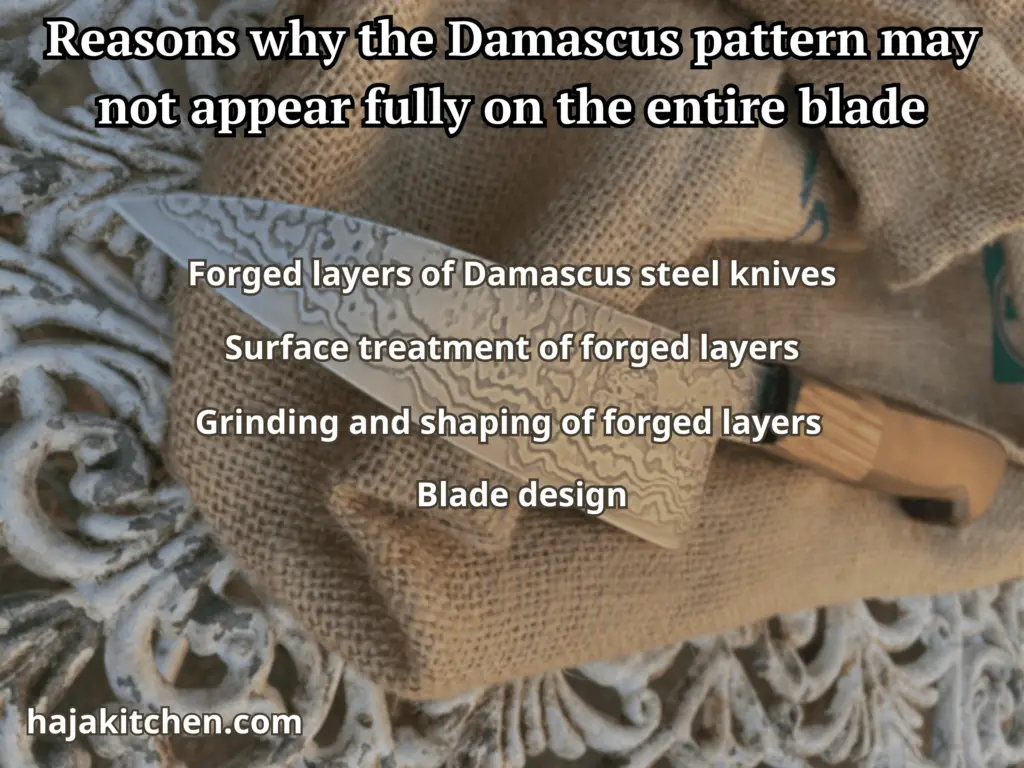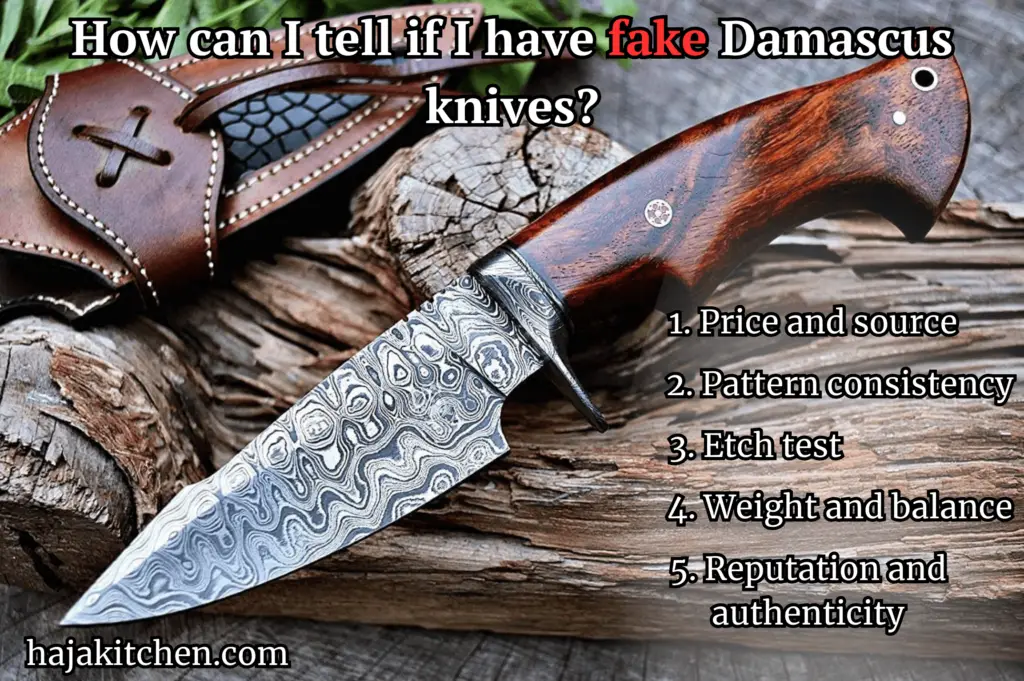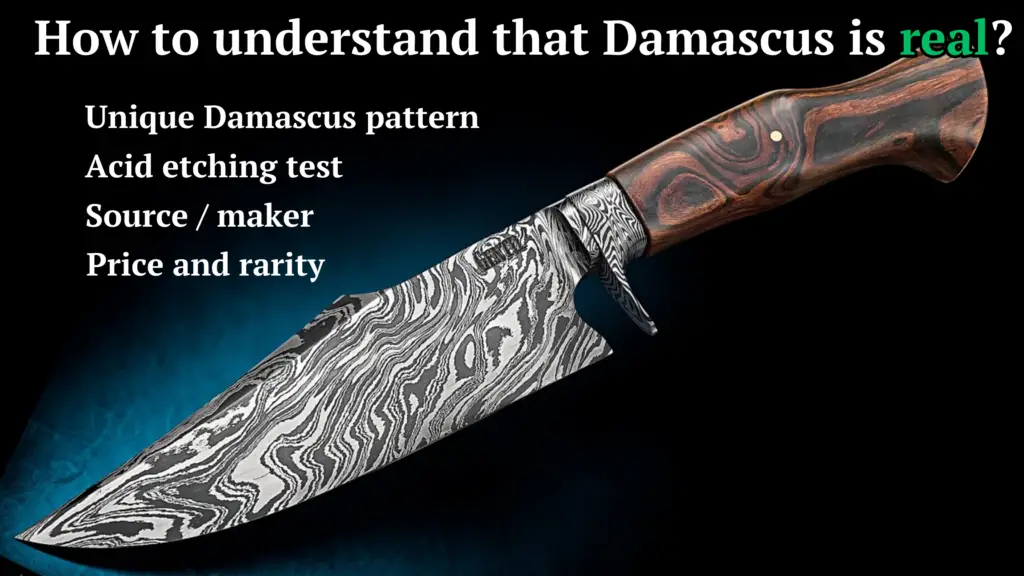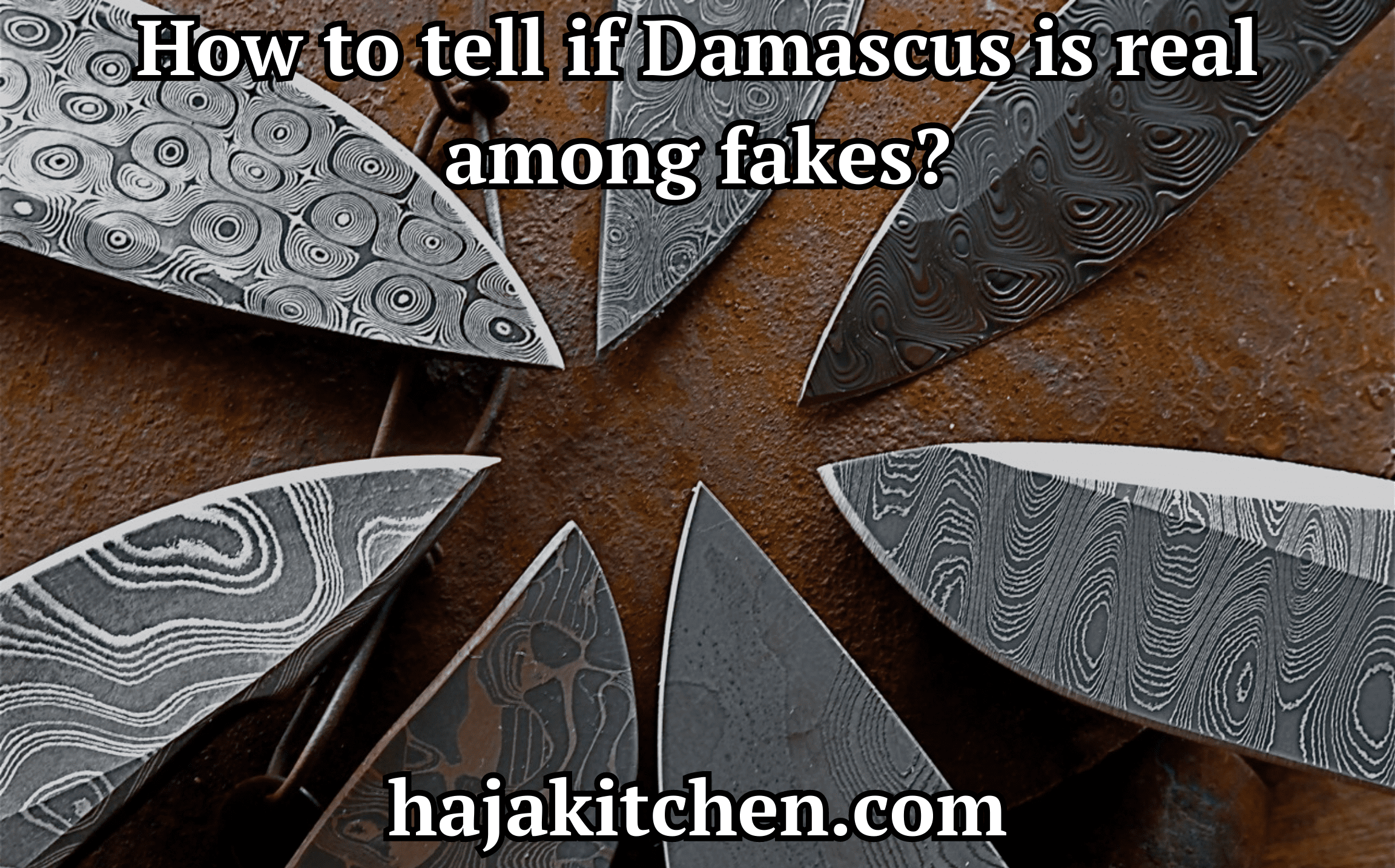People are eager to acquire Damascus steel knives due to their captivating patterns and extraordinary durability. However, with their popularity, there has been an increase in the production of counterfeit Damascus steel knives.
Counterfeit Damascus knives: Some unscrupulous manufacturers create fake Damascus patterns by acid etching or laser etching the surface of a regular steel blade.
Low-quality materials in Damascus’s steel knives: Fake Damascus steel knives are often made from low-quality materials that are not heat-treated properly.
Substandard craftsmanship: The distinctive patterns of authentic Damascus steel knives are a result of skilled artisans who hand-forge them. On the other hand, counterfeit Damascus steel knives are devoid of the skillful artistry and meticulousness found in authentic Damascus steel knives.
Inconsistent patterns: Each Damascus blade has a distinct pattern, resulting from the layering of different steels during the forging process.
Price: If a Damascus steel knife is sold at an unusually low price, it could indicate that it is fake Damascus steel knives. This is mainly because genuine Damascus steel knives are generally pricier than regular knives, owing to their exceptional craftsmanship and superior quality.
To avoid buying fake Damascus steel knives, it is important to purchase from reputable dealers who can provide certificates of authenticity or traceability. So, let’s continue discuss how to tell if Damascus is real among fakes.
What are Damascus steel knives?

Before establishing the authenticity of your Damascus material, it is vital to begin by clearly defining the essence of what Damascus truly represents.
Damascus’s knives refer to the captivating and mesmerizing wave-like design found in steel, which possesses an exotic and extremely appealing appearance.
While oversimplifying the concept, it is essential to comprehend that the production of authentic’s Damascus steel can be accomplished through two techniques: Wootz steel and pattern-welded steel.
All these knives have stainless steel blades.
Stainless steel blades are key elements of a genuine Damascus steel knife.
Wootz steel

Wootz steel, alternatively called Damascus steel, is a specific variety of crucible steel for Damascus steel knives that originated in the geographical areas encompassing India and Sri Lanka.
These pattern-welded Damascus blades are widely recognized for their unique undulating designs and extraordinary durability.
The production of Wootz steel, such as Damascus steel knife, involves a complex process of smelting iron ore with carbon, often using materials such as wood, leaves, or charcoal as a source of carbon.
What sets Wootz steel pattern welded Damascus blades apart is the presence of carbides, microscopic particles formed during the solidification process, that contribute to their unique patterns.
These Wootz steel patterns are the result of the diffusion and segregation of various elements during the solidification process, creating bands or lines of different colors and textures.
During ancient times, the exceptional attributes of Wootz steel, including its exceptional hardness, toughness, and resistance to shattering, led to a high demand for its usage in the creation of weapons and armor.
Particularly, swords crafted from Wootz steel were highly valued for their sharpness and long-lasting nature.
However, as time passed and the 19th century arrived, the production of Wootz steel witnessed a decline and eventually vanished.
Various factors were attributed to this downfall, including the depletion of crucial raw materials, advancements in steel manufacturing practices, and the decline in knowledge and expertise surrounding traditional production methods.
Pattern-welded steel

Damascus steel, also referred to as pattern-welded steel, is produced through the technique of forge-welding multiple layers of distinct steel types. This technique originated in the Middle East and was widely used in the production of high-quality swords and blades during the medieval period.
To create a layered design, pattern-welded steel is crafted by folding and twisting various steel types, commonly iron and high-carbon steel. The layers of carbon steel are heated in a forge and hammered together, which creates a strong bond between the metals.
The resulting pattern can be seen on the surface of the steel and is known for its distinctive wavy or mottled appearance. These pattern-welded Damascus knives of carbon steel are formed by the contrasting layers of different steel types, which react differently to the etching process that is often used to highlight the pattern.
Why is Damascus not everywhere visible on the blade?

The visibility of the Damascus knife pattern on a blade depends on several factors, such as the craftsman’s skill, the specific technique used, and the desired design for the Damascus steel blades.
Here are several possible reasons why the Damascus pattern may not be fully visible on the entire blade:
- Forged layers of Damascus steel knives: The unique designs seen on the blades of Damascus steel are achieved by combining different types of steel, then repeatedly folding, twisting, and forging the layered steel.
- Surface treatment of forged layers of Damascus steel knives: After forging, blades are typically subjected to surface treatments like etching or polishing to highlight the Damascus knives’ pattern. However, this treatment may not be applied to the entire blade uniformly, resulting in variations in visibility.
- Grinding and shaping of forged layers of Damascus steel knives: During the blade shaping process, excess material is removed through grinding or filing. This can inadvertently remove or obscure some of Damascus’s patterns.
- Factors to consider when designing Damascus steel knives with forged layers: The level of visibility of the Damascus pattern can vary based on the desired blade design. Certain blades might showcase a complex and widespread pattern welded Damascus, whereas others may opt for a more straightforward and consistent look.
The visibility of the pattern-welded Damascus is often a conscious decision made by the bladesmith for aesthetic reasons.
The overall visibility of the Damascus steel knife’s pattern on its blade can differ depending on the methods utilized, the expertise of the person crafting the blade, the design elements incorporated, and the particular aesthetic desired.
How can I tell if I have fake Damascus knives?

Identifying the authenticity of a Damascus steel knife can be a daunting task, especially for those lacking expertise in Damascus steel knife assessment. Nonetheless, several key indicators of whether a knife is real or fake can assist in differentiating genuine Damascus knives from fake Damascus knives:
• Price and source of Damascus knives: Genuine Damascus steel knife is usually more expensive due to the craftsmanship and materials involved in the production.
If you find a Damascus knife boasting the Damascus steel knife pattern at unusually low prices, it might suggest that it’s a fake Damascus knife.
Additionally, be cautious when purchasing from unknown or unreliable sources. They also sell fake Damascus steel knives.
• Pattern consistency: The distinctive and exquisite design of the Damascus steel knife is a result of the intricate layering and folding of various types of steel. It is important to closely inspect the pattern on the blade.
The layering technique used in crafting authentic Damascus knives results in blades that showcase consistent and intricate patterns spanning their entire length.
In contrast, fake Damascus steel knives may display a design that is artificially engraved or imprinted onto the blade, devoid of the genuine flow and harmonious appearance characteristic of real Damascus knives.
• Etch test: You can use an etch test as a method to establish the authenticity of a Damascus knife. By applying mild acid-like vinegar to a small portion of the blade, you can observe if there are visible layers made of different steels, providing evidence of a real Damascus construction.
• Weight and balance: Damascus knives are typically well-balanced and have a good weight distribution. If you notice that a supposed Damascus knife feels unusually heavy or imbalanced, it could be an indicator of a fake Damascus knife.
• Reputation and authenticity: Research the brand’s or manufacturer’s reputation for producing genuine Damascus knives. Read reviews, seek recommendations from experienced knife users, and look for reputable sellers specializing in high-quality knives.
Authenticating a Damascus knife can be easier with the guidance of experts or reputable sources. So, it will be easier not to run into a fake Damascus knife.
If you know how to identify a real or fake Damascus knife, the purchase will be easy.
How to understand that Damascus is real?

Identifying if Damascus steel knife real or fake can pose a difficulty, but certain crucial elements can assist in verifying its authenticity. Listed below are some suggestions to aid you in distinguishing an authentic’s Damascus steel knife real from a fake.
One can identify a real Damascus steel knife by its unique Damascus pattern, which consists of elegant swirling or flowing ridges. This exquisite pattern is formed through the meticulous folding and layering techniques used in crafting Damascus steel.
Inspect the metal to check for visible layers or lamination to identify the distinctive pattern that genuine Damascus steel is known for. This pattern is created by the composition of multiple layers of different types of steel.
Authentic Damascus often exhibits wavy or curved lines on the surface due to the folding and reforging processes. These lines are a result of the variations in the steel layers and contribute to the beautiful pattern.
An acid etching test can be utilized to identify Damascus steel, although it is not completely reliable. By applying a mild acid etching like lemon juice or vinegar to a small portion of the metal, one can observe if the acid reacts differently with the layers, creating a distinctive contrast.
This acid etching reaction hints at the possibility that the metal might be Damascus steel. The acid etching test can indeed be utilized to identify Damascus steel.
To perform the acid etching test, a small section of the suspected Damascus steel is first cleaned and polished. Then, an acid etching solution such as ferric chloride or nitric acid is applied to the surface. The acid etching reacts with the different types of steel in the Damascus pattern, causing them to darken or develop contrasting colors. It depends on whether the Damascus steel blade is real or fake.
Gather information about the maker or source of Damascus steel to assess their reputation and expertise. Legitimate producers will have a history of crafting genuine Damascus steel, which can aid in verifying its authenticity.
Consider the price and rarity of real Damascus steel knives. Authentic’s Damascus steel is typically quite costly due to the complex and labor-intensive process required to create it. If you come across an exceptionally cheap offer, it is likely too good to be true and may imply that the material is not genuine.
Conclusions

We showed you how to determine real or fake Damascus knives. You need to choose Wootz steel or pattern-welded steel when buying a knife. Wootz Damascus steel is a quality material for making real Damascus knives.
In stores, you can also buy Damascus pocket knives. It is easy to tell a fake Damascus steel knife from a real one in many ways.
Fake Damascus steel blades have few patterns and are cheap. A real thing is always made of stainless steel with special patterns.
Also, a knife is real, typically pricier than a fake.
FaQ
Q: Can you fake a Damascus knife?
Yes, it is possible to fabricate a counterfeit Damascus blade. Damascus blade, renowned for their unique swirling designs, were traditionally crafted by fusing multiple layers of different steel types.
However, producing authentic’s Damascus steel is a complex process that demands specific expertise and knowledge.
Q: Is there any real Damascus steel?
Unfortunately, a real Damascus steel blade is not known to exist in the present day. The original Damascus blades, famous for their strength, flexibility, and appealing swirling patterns, were once used to craft blades in the Middle East during the medieval era.
Its distinct qualities were achieved through a unique manufacturing process. Nonetheless, the specific techniques and knowledge required to produce authentic’s Damascus blades have been lost over time. Modern attempts to replicate it have fallen short of fully capturing its original properties.
As a result, the term “Damascus steel” is now commonly used to describe pattern-welded steel or other materials that resemble its appearance. However, these alternatives do not possess the same characteristics as the original Damascus steel.
Q: What is true Damascus steel?
True Damascus steel, also called Wootz steel, was produced in ancient India and Sri Lanka and is renowned for its distinct surface patterns that give it a one-of-a-kind and elaborate look.
This type of steel was highly prized due to its remarkable strength, sharpness, and durability.
It is important to mention that the term “Damascus steel” is also used more generally to refer to contemporary pattern-welded steel that aims to mimic the appearance of a real Damascus steel knife.
These modern replicas are made by layering and forging various steel types, often resulting in exquisite and intricate patterns on the surface.
Q: Is modern Damascus steel fake?
Modern Damascus steel is not counterfeit; instead, it is a genuine type of steel renowned for its elaborate designs formed by delicately folding and layering different steel types.
This traditional technique emerged in the Middle East and was historically employed to craft exceptional swords and knives.
Although the original manufacturing process was gradually forgotten, contemporary blacksmiths have ingeniously devised diverse approaches to replicate its extraordinary patterns and qualities.


